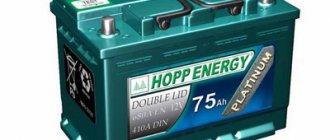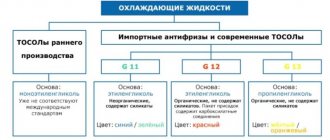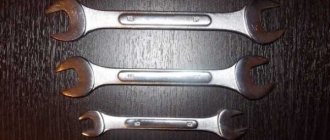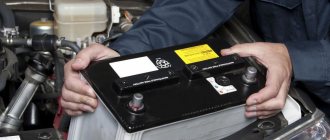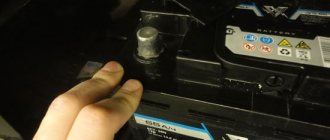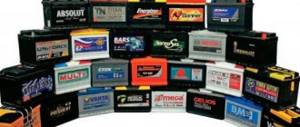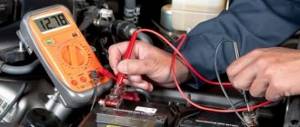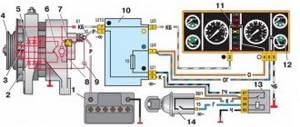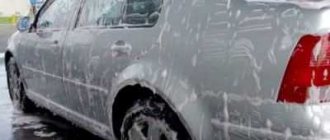How much liquid should I add?
The amount of water added to the battery depends on how low the level is inside the cans .
Sometimes, it is enough to pour in 50 ml to restore the battery's functionality.
If distilled water has not been added for a year or more, the contents may almost completely evaporate .
Each jar of a new battery contains an average of about 700 ml of distillate.
When water evaporates, the volume may decrease slightly (with regular maintenance), so if the decrease in level did not occur as a result of the battery tipping over, then to restore the battery’s functionality it will be enough to purchase a liter container of distilled water. Attention!
Only chemically pure water can be used to top up the battery.
Consequences of non-compliance with proportions
If the proportions are not met, the battery will not be able to accumulate the required amount of electric current.
If the battery is operated with a low level of distilled water for a long time, the chemical power source may fail due to excessive oxidation of the internal plates of the battery.
This process is observed if the lead gratings, which interact with air, are completely exposed. In turn, the resulting dielectric film prevents the normal passage of current.
Consequences of overflow
When overfilled, the battery's ability to store electricity is sharply reduced.
A higher level may cause other undesirable consequences during battery operation.
If the cans are filled to capacity, then when the battery is used in a car, the contents will splash while the car is driving on a bumpy road. Constant contact of the body metal with water and electrolyte will lead to the appearance of rust and through corrosion.
Also for this reason, the battery terminals may oxidize. The presence of a dielectric layer on wires and contacts can cause serious deviations in the operation of the vehicle's electrical system.
Attention! If the battery is used stationary, then the release of water when overfilling the cans is also possible. When charging the battery at high currents, including when the charger is connected for a long time at the recommended charge level, the contents may “boil”.
This phenomenon is the active movement of gas bubbles inside the electrolyte. Splashing acid can also lead to damage to various metal objects, as well as cause the growth of bacteria and fungi due to the presence of high humidity in the room.
Harm of underfilling
An insufficient amount of distillate in battery banks can lead to complete failure of the electricity source. Inexperienced car enthusiasts very often neglect regular battery inspections with mandatory checking of the cans.
For this reason, especially in the summer, the car simply may not start. If the machine is operated in a cool climate, the distillate level may decrease very slowly.
A gradual decrease in the amount of mixture in the jars causes an acceleration of the sulfation process of the plates.
Oxidation of the lead grid is one of the main reasons for reducing battery life.
Insufficient distilled water will equally negatively affect the performance of a rechargeable source of electricity, regardless of whether the product is used on a machine or stationary.
Attention
! If you do not take care of the battery, then it will be impossible to restore the current source after severe sulfation by adding distilled water.
Why is distilled water added to the car battery and what is it?
A certain amount of distilled water in the liquid inside the battery is a necessary component. It is this that ensures full operation of the battery, maintaining the optimal density of its electrolyte. It consists of 65% sulfuric acid, and the percentage of sulfuric acid in it should be much less - only 35%.
Since sulfuric acid is a useful, but very dangerous and highly concentrated chemical compound, purified water acts as a lowering level of its concentration to a useful one that will not harm the battery.
Moreover, the 65:35 ratio level in the battery precisely ensures the process of accumulating electrical energy inside it during the charging process. This energy will then be consumed when starting the engine and driving the car.
What is distilled water? This is a pure liquid that has been distilled, that is, purified. It consists of three atoms, two of which are hydrogen and the other oxygen, and does not contain any additional impurities, which may consist of salts and other substances .
Before you find out the answer to the question of how much distilled water to add to the battery, it is important to understand that you cannot pour ordinary water into the battery . A large level of impurities in the form of chlorine, salts and even lime, which will settle on the lead plates of the battery, will quickly lead to sulfation and failure.
Boiled water cannot be poured into the battery either : simple boiling without the use of certain technologies does not distill its composition properly. Simply taking and boiling water does not mean purifying it completely.
There is an opinion that distilled water can be prepared at home. But, since this process is quite labor-intensive and energy-consuming, it is best to purchase it in specialized stores, paying attention to the shelf life, which, on average, is about a year.
Factors affecting distillate volume
When operating batteries that use distilled water inside the cans, you need to be aware of the reasons for the decrease in level . Most often this pathological process is observed:
- At high air temperatures.
- When the battery is overheated as a result of charging or discharging with high currents.
- Depressurization of the housing.
- When driving the vehicle on a bumpy road.
- As a result of excessive angular tilt of the machine.
To a small extent, the level of distilled water can also be influenced by atmospheric pressure and air humidity.
What level should the battery be?
In a 55 Ah battery, the optimal amount of content is about 2.5 liters.
An equal amount of distilled water is poured into each battery jar .
If a 12-volt battery is used, then to obtain the required voltage, the battery will consist of 6 series-connected banks. Accordingly, each cell will have 416 ml.
Testing distilled water
Distilled water can be tested for quality. A liquid cleared of impurities does not conduct current; the testing method is based on this indicator. To carry out the experiment, you will need a small piece of wire, a regular 15-40 Watt light bulb and a plug into the socket. One end is connected to the socket into which the light bulb will be screwed. The second end is cut, the wires are exposed and stripped. The plug is inserted into a socket connected to a 220 V network, and the prepared ends are inserted into a container of water. If the liquid is completely cleared, the light will not light up. If there is even a small amount of impurities, the light will turn red.
Advice! When performing this procedure, extreme caution should be used.
How to check?
You can check the amount of fluid in the battery visually. Many battery models are made of translucent plastic. Min and Max marks are often placed on the outer side surface of such products.
Reference! If the level of distilled water is between the Min and Max designations, then the battery can be used for its intended purpose without any restrictions.
If the battery is made of durable material of considerable thickness, then in such products, manufacturers install plastic elements inside the cans that hang from the lid of the product. When these “beacons” are reached, the level will be considered optimal.
To check the level of distilled water, you can use a plastic stick, which should be lowered into the opening of the jar and touch the plates with it. Then you need to measure the part of this “indicator” soaked in the mixture. The normal electrolyte level above lead grids can be considered 15 - 18 mm.
You can also take measurements using a transparent glass or plastic tube. Such a product must be lowered into the jar until it stops at the top of the lead gratings.
Then close the hole with your finger and lift the handset. As a result of such actions, a certain amount of water will end up in the hollow product. The height of the column can be used to judge the distillate level.
What is better to add to the battery - electrolyte or distilled water?
As a rule, the need to add fluid to the battery occurs in the following cases:
1. Evaporation of water from the battery, and as a result, a decrease in the electrolyte level until the plates are exposed;
2. Significant leakage of electrolyte due to poor sealing of the cover to the battery body;
3. Leakage of electrolyte due to damage to the battery box, impact, etc.
In the first case, only distilled water is poured in!
In the 2nd and 3rd cases, electrolyte with a density of 1.26-1.28 g/cm3 is poured into the corresponding damaged battery jar!
Depending on the damage, the battery can be repaired. But, it is best to do this in a service workshop.
Exposing the battery plates leads to loss of capacity of the car battery, warping of the lead plates, i.e. destruction of the battery and its rapid failure.
Any regular acid-base battery is filled with electrolyte.
The electrolyte consists of the ratio
- sulfuric acid
- distilled water.
The liquid ratio is approximately 35% acid and 65% distilled water.
A smaller or larger ratio is not desirable! A higher acid ratio will increase the concentration of acid in the battery, which means the acid will corrode the lead plate packs, which will lead to rapid failure of the battery.
A lower acid ratio will indicate a low battery and a risk of liquid freezing in winter.
The density of the electrolyte is an indicator of the ratio of the concentration of acid and water, which is measured in grams per cubic centimeter. Density can be measured with a hydrometer.
A fully charged battery at room temperature has an electrolyte density of 1.27 - 1.28 g/cm3.
The liquid in the battery should cover the top of the plates by 1.1-1.5 cm.
To add fluid to a serviced battery, you simply need to unscrew the plugs from the battery filler holes and pour in distilled water.
After adding distilled water to the battery in the appropriate section or sections of the battery, the battery is charged until fully charged.
Distilled water cannot be added to a maintenance-free battery.
It is worth remembering that any damage to the case is a non-warranty case when the manufacturer's warranty is void.
However, to solve such problems, you can always contact a specialized service to provide services.
Online store of the First Battery Company
Share:
What to do if you overfill it?
When adding distillate to jars, it is possible to accidentally exceed the maximum level.
Considering the possible negative consequences, overflow must be eliminated.
This operation is performed very simply:
- Using a rubber bulb or hydrometer, remove excess (it is recommended to lower the level below normal).
- Add a small amount of distillate (to the optimum level).
When adjusting the electrolyte level in jars by adding distilled water, it is recommended to monitor the density with a hydrometer.
Attention
! It is strictly forbidden to reduce the level of distilled water in the battery by tipping the product on its side. As a result of such actions, a short circuit may occur in the lead plates.
How to check the level and how much to add
There is a special device designed to determine the level of required concentration of the mixture in the device - a hydrometer. The object is dipped into the solution, and then the concentration of the substances is checked. During operation, the device should not come into contact with the glass walls, which is why it is held in a vertical position in front of you.
If the readings are high, it is recommended to add the required amount of water to the device. It's easy to see when and how much liquid to add by looking at the lead plates. If the substance does not completely cover them, distillate is added to the battery in such an amount that the composition completely covers the sheets.
Important!
In modern models of devices made of plastic, distillate is poured according to a scale drawn on the body of the model. It is necessary to adhere to the marked level.
It is imperative to add a water component, especially when the device shows high density indicators of the composition. If you ignore the problem, the battery may overheat. Consequently, a breakdown will occur. If the car owner does not systematically add fluid to the battery, the amount of acid in it increases and the battery lasts much less.
With old batteries, things are a little more complicated. As a rule, the battery must have a special “tongue”. Water must be added to the battery until the electrolyte level is 5 mm above it. If there is no “tongue”, then add until the mark is 1 cm higher than the top of the plates.
It is prohibited to add a component to an autonomous power source in a car if the engine has just been turned on. It is important to let the battery sit for at least a couple of hours before opening it. After adding this component, you cannot immediately turn on the internal combustion engine. The battery needs to sit for a while, otherwise it will boil.
